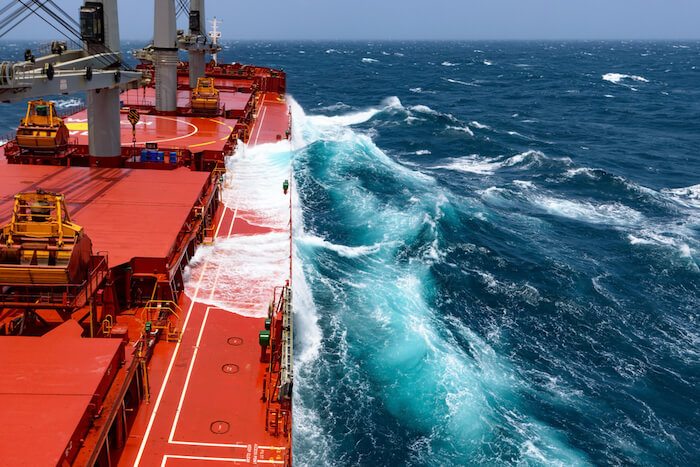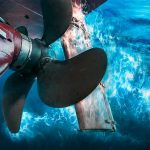In manoeuvring, a ship experiences yaw (rotation about a vertical axis) and sway (sideways motion). More generally, motions are possible in all six degrees of freedom, the other four being roll (rotation about a longitudinal axis), pitch (rotation about a transverse axis), heave (vertical motion), and surge (longitudinal motion superimposed on the steady propulsive motion). All six are unwanted except in the special circumstance where yaw is necessary in changing course.
Roll is probably the most unwanted of all, since it produces the highest accelerations and hence is the principal villain in seasickness. It can be described as a forced vibration, since the mass, damping, and restoring force typical of any mechanical vibrating system are present. However, attempts to find the natural frequency of a rolling ship through analysis are far from simple, because the coefficients of the fundamental equation are themselves a function of frequency. Further, the mass term must include a rather indefinite amount of water that moves with the ship as it rolls, and there may be coupling between roll and one of the other motions. Nonetheless, natural rolling periods can be found approximately from simplified formulas. Rolling is most severe when the period of encounter with a major part of a wave spectrum equals the roll period.
Many ships are fitted with “bilge keels” in an attempt to dampen roll. These are long, narrow fins projecting from the hull in the area where the bottom of the hull meets the side. Bilge keels are effective in reducing roll, but they are much less effective than other measures. The most effective are antiroll fins that extend transversely from the side of the ship for perhaps 30 feet (10 metres) and are continuously rotated about their axes to develop forces that oppose the roll. Among the sizable costs associated with these fins is the necessity to retract them within the hull when the ship is to be docked.
Pitch is simply roll about a different axis, but consequences and solutions are different. Because a ship is much longer than it is wide, an angle that may seem trivial when it measures roll may lift the bow out of the water when it measures pitch. When the period of encounter with head seas is close to the natural pitching period of the hull, slamming of the bow and cascading of waves upon the forward decks are possible consequences. The most common response to such a hazard is slowing the ship to avoid the resonance. Experiments have been made with anti-pitching fins, but they have not entered into general practice.
The study of ship interaction with surface waves has seen intense effort by hydrodynamicists, since it is a difficult field in which to extract meaningful results from theory while being one where the benefits of solutions are great.
Structural integrity
The simplest structural description of a ship is that its hull is a beam designed to support the numerous weights that rest upon it (including its own weight), to resist the local forces produced by concentrated weights and local buoyant forces, and to resist the several dynamic forces that are almost certain to occur. As with any structure, stresses at all points must remain below the limits allowable for the construction material. Likewise, deflections both local and overall must be kept within safe limits.
In a long-favoured application of beam theory to the design of a ship’s hull, the ship is assumed to be supported by a quasi-steady wave (i.e., not moving with respect to the ship) of a length equal to the length of the ship and one-twentieth of this length in height. The ship is taken to be supported by wave crests located at its bow or stern or by a single crest at its mid-length. The hull length is divided into 20 segments, and the weights and buoyant forces within each segment are carefully tabulated. The difference between the sum of all weights and the sum of all buoyant forces within each segment is treated as a load uniformly applied over the segment. The 20 loads are then plotted as a function of position along the hull, and the resulting curve is integrated over the entire ship’s length to give what is known as the shear curve. In turn, the shear curve is integrated over the length to give the bending moment curve—a curve that usually has its maximum near mid-length. A value for bending stress can then be obtained by dividing the maximum bending moment by a beam section modulus of the hull structure, which is calculated from a detailed structural plan. For protection against loads neglected in the analysis, such as dynamic wave loads, ample design margins are employed in the calculations.
Since about 1990 the quasi-static treatment of wave loading, as described above, has been recognized as inaccurate. The preferred treatment has become one of finding a still-water (i.e., level sea surface) bending moment, then adding to it a wave-bending moment found by an empirical formula and based only on the size and proportions of the ship. Coefficients in the formula are based on data obtained from at-sea measurements and from tests of structural models; as a consequence, the formula has been found to give predictions that seem to be in satisfactory agreement with reality. The formula is published among the rules of the classification societies that govern the design of commercial ships.
Nevertheless, although a single formula may serve well for ships of typical configuration in sea conditions encountered in typical service, it is not sufficient for all ships in all circumstances. For this reason, research continues into the interactions between the sea and floating structures, the goal being to be able to calculate a load resulting from any interaction between the sea and a floating body. The task is difficult because the analyst must be able to calculate the motion of a ship as caused by waves, the effect on waves of the motion of the ship, and buoyant, damping, and inertial forces present. Such a task would be impossible without extensive at-sea measurement and model testing and without the use of major computing resources. The computing resources became generally available in the 1970s and have encouraged efforts that will likely continue well into the 21st century.
Interactions between waves and hull also may occur in a dynamic mode. An obvious example lies in the impact between moving wave and moving hull. Generally, the results of this impact are of small consequence, but the slamming that can occur in rough weather, when the bow breaks free of the water only to reenter quickly, can excite “whipping” of the hull. Whipping is a hull vibration with a fundamental two-noded frequency. It can produce stresses similar in magnitude to the quasi-static wave-bending stresses. It also can produce very high local stresses in the vicinity of the reentry impact.
Another wave-excited hull vibration that can produce significant stress is known as springing. The cause of springing is resonance between the frequency of wave encounter and a natural vibratory frequency of the hull. Slamming and the consequent whipping can be avoided by slowing or changing course, but springing is more difficult to avoid because of the wide range of frequencies found in a typical sea state. Fortunately, springing has not been identified as a cause of any known structural failure.
Adequate calculation of such dynamic forces and their consequences also requires large computing resources, and hence it was not seriously attempted until about 1980. Major progress has been made, but techniques still have not been reduced to standard design practice.
The traditional ship hull structure consists of a keel, transverse frames, and cross-ship deck beams that join the frame ends—all supporting a relatively thin shell of deck, sides, and bottom. This structural scheme, which became prevalent with European ships during the Middle Ages, has continued into the age of steel shipbuilding. However, it has a significant drawback in that the frames and deck beams contribute nothing toward resisting longitudinal bending. Frames that run longitudinally do contribute to such resistance and thus permit thinner shell plating. This scheme of framing is strongly favoured in applications where weight saving is important. However, longitudinal frames require internal transverse support from bulkheads and web frames—the latter being, in effect, partial bulkheads that may extend only three to seven feet in from the shell. This requirement obviously reduces the weight advantage of longitudinal framing but not enough to negate the advantage entirely. Web frames also have the drawback of interfering with some uses of interior space, and as a consequence the simple transverse system of framing continues to be employed in many ships.


